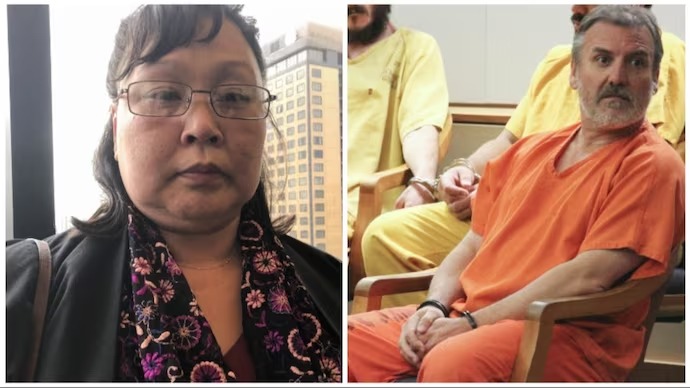Memory card taken four years ago is crucial to the trial of two murders in Alaska
A lady who had been picked up by a guy for a “date” close to downtown Anchorage had a long criminal past that included theft, violence, and prostitution. The two got into a vehicle together. She took a digital memory card from the center console when he left her in the car by herself.

Now, over four years later, what she discovered on that card is crucial to a double murder trial that is scheduled to start this week: graphic images and videos showing a woman being beaten and strangled at a Marriott hotel, her attacker urging her to commit suicide while speaking in a thick accent, and her body covered in blankets being secreted outdoors on a luggage cart.
On one video, the speaker adds, “Everyone always dies in my movies.” “What will my supporters think of me? People must be aware of when they are the target of serial killings.
The lady gave the SD card to the police about a week after she grabbed it, and they claimed to have identified the voice as that of 52-year-old Brian Steven Smith, a native of South Africa who they had previously investigated, according to court records.
Smith has entered a not guilty plea to 14 counts pertaining to the murders of Veronica Abouchuk, 52, who was reported missing by her family in February 2019, seven months after they last saw her, and Kathleen Henry, 30, which include first- and second-degree murder, sexual assault, and tampering with evidence.
Both Henry and Abouchuk were Native American women from Alaska who had been homeless. Henry was from Eek, and Abouchuk was from Stebbins; they were both from little towns in western Alaska.
Henry was the victim, according to the authorities, whose passing was noted at the TownePlace Suites by Marriott in downtown Anchorage. Smith was scheduled to remain there from September 2 to September 4, 2019. According to authorities, the first photos revealing Smith’s corpse were time-stamped at about one in the morning on September 4.
According to charging papers, the final photos on the card were taken early on September 6 and showed Henry’s corpse in the back of a black truck. According to location data, Smith’s phone was in the vicinity of Rainbow Valley Road, south of Anchorage, along the Seward Highway at the time the picture was taken. This is the same region where Henry’s corpse was discovered a few weeks later, according to the police.
Smith provided more information to police when they led him to a bathroom during his questioning by detectives regarding the Marriott case, according to the authorities. He had killed a second woman, whose identity he later gave to police based on a photo, and he also gave the location of her remains, which were found along the Old Glenn Highway north of Anchorage.
“He tells the troopers in the bathroom, ‘I’m going to make you famous,’ without any prompting,” District Attorney Brittany Dunlop said last week in a court proceeding. “When he returns, he asks, ‘You guys have any more time? Do you want to speak further? And goes on to reveal this second murder.
Because Abouchuk’s ID was found with the corpse in 2018, Alaska State Troopers mistakenly recognized another body as that of Abouchuk for reasons that are still unknown. However, armed with Smith’s knowledge, police reopened the case and utilized dental records to establish that the skull recovered in the location Smith had located belonged to Abouchuk.
Timothy Ayer, Smith’s lawyer, attempted in vain to have any mention of the digital memory card—or any proof of it—excluded from the trial. The lady who gave in the card first claimed to have just discovered it on the street, and only in a follow-up interview did she admit that she had taken it from Smith’s vehicle while he was attempting to withdraw cash from an ATM. She kept the card for a week before handing it over to the police, he said.
He said that as a result, the prosecution would be unable to show where the 39 images and 12 films came from, determine if they were copies or originals, or determine with certainty whether they had been altered.
“A witness cannot be produced by the state to attest that the video faithfully and fairly portrays any act that actually occurred,” Ayer said.
Late on Friday, however, Third Judicial District Judge Kevin Saxby made the decision that the lady could testify on her ownership of the card up to the point at which she turned it in to the police and that the recordings could be legitimately verified.
Henry’s family has not publicly discussed her passing, and attempts to get in touch with family members have not been fruitful. The Associated Press has not received a response from Abouchuk’s family.
Following Smith’s indictment in 2019, Dunlop, who was the assistant district attorney at the time, said, “These were two Alaska Native women.” And we’re aware of the fact that it resonates here in Alaska. We show them respect and decency.
Smith, who is being held at the Anchorage Correctional Facility, is alleged by the authorities to have arrived in Alaska in 2014 and naturalized as a citizen of the United States in the same month that Henry was slain.
He refused to talk about the matter in a 2019 letter to the AP. He went on to say that he was doing well, saying, “I am sober, I have lost weight, and I have much less stress.”
Both his sister serving as a family spokesman in South Africa and his wife Stephanie Bissland of Anchorage refused to speak until after the trial.
Jury selection for the trial, which is anticipated to take three to four weeks, was set to start on Monday.
To stop the public from seeing the graphic films, the prosecution had proposed that the courtroom be closed. In a letter to the court’s presiding judge, the Associated Press, the Anchorage Daily News, Alaska’s News Source, and Alaska Public Media protested to any such action.
Subsequently, Saxby said that although he has no plans to exclude the public from the courtroom, measures would be taken to ensure that people in the gallery or following the trial livestream cannot see them.







